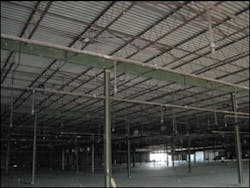Commercial Construction Considerations: Buildings Under Construction and Renovation
Over the last year, this series of articles has been devoted entirely to the discussion of building systems. All of the major building systems were covered, so that you could gain a basic understanding of the systems. As this column continues, I will dedicate time to discuss specific issues pertaining to these systems as well as issues directly related to building construction and the fire service.
The first issue that bears some discussion given the current state of the economy nationwide is the danger involved with fighting fires in buildings under construction and buildings under renovation. Even more we need to start thinking of some if the dangers in buildings that are partially constructed and now construction has stopped due to the economy and these building are now sitting idle or vacant.
Buildings Under Construction
The first topic to discuss is buildings that are under construction or under renovation where work has stopped. There are many hazards associated with a fire in this type of facility. One of the most obvious is there will be no project manager or construction superintendent on site to ask questions. Under normal circumstances when there is a fire at a construction site you may have had some interaction with the project management staff on site to get an idea of what is being constructed and the sequence of construction.
If this fire were to occur during normal working hours generally there would be someone on site or someone a phone call away. It may be more difficult to obtain this information once construction has stopped and there will not be anyone on site.
Another obstacle will be access to the facility. We all know that most construction sites are fenced and in general not easily accessible. There are a couple of points to remember on site access. You will find one of two situations when you arrive -- either the security has been increased to decrease theft or the site has been left largely wide open.
The situation of increased security is something firefighters should be able to easily deal with, using basic forcible entry techniques. The later may be more difficult to deal with including the theft of components of systems, such as standpipe and sprinkler systems that have already been installed which could hinder firefighting. Also there is the possibility that these structures will be used by vagrants as a place to stay during these cold winter months.
However the most obvious hazard is that the work is not complete, I know many of you are saying "of course the work is not complete why is that the greatest hazard?" We remember back to the previous articles specifically in regard to a building's structural systems. Buildings are complex and a variety of systems are required to work together in order to complete the building. Once again I will say that it is imperative that you have an idea of the condition of the structures in your response area.
A Variety of Hazards
This includes structures under construction, structures partially constructed, structures where construction has stopped, occupied and unoccupied structures. As I was saying building components are designed to work together as a system and may not work very well on there own. The most obvious example of this is structural systems that are designed to have some type of fire protection. Steel is often encased in concrete, wrapped in gypsum board, or covered with some type of fire proofing. Well if the steel was installed and the project was stopped before the steel could be protected you are dealing with a structure that will loose its structural integrity in a relatively short period of time. The same can be said of the roof. Many times the roof design will consist of a gypsum board roof deck, to meet code required fire ratings. As we know, gypsum board is very susceptible to moisture, if the entire roofing system was not installed and the gypsum decking is now wet and you attempt to ventilate the roof you will be in trouble when you step in it before sounding it.
Some of the other obstacles that you may encounter include open elevator shafts without protection, incomplete stairwells, and incomplete sprinkler and standpipe systems. You may also find in buildings under renovation that the sprinkler system has been left in an inoperable state. In some buildings under renovation were the heating system is not operable the water in the system may have frozen and the pipes burst. This can pose a significant issue if the pipe is broken before the fire room. Another significant obstacle in buildings under construction or renovation is the standpipe system; this can be of particular concern in multistory facilities.
The final hazard which bears discussion and is very difficult to quantify is the general condition of the interior. More than likely there will be construction material left lying around which will create obstacles in moving around. In many buildings under renovation asbestos removal must take place. This often requires the installation of temporary enclosures generally made out of plastic that can easily disorient and trap a firefighter. You also need to think about whether it is a large open area or if framing or walls are in place. One other item to pay attention to is construction debris hanging from the ceiling or roof which may snag on your gear. Examples include telecom and power wiring, ceiling grid and the wire that holds both the grid and other materials up.
Working in vacant and partially constructed buildings is a part of the job we have dealt with for many years. However with the contraction of the economy and the credit market I believe it is something we will be dealing with more often. The only way we can know the condition of a facility is tour it. While this may be difficult it needs to be done. We need to work with facility owners to do our best to make sure these buildings are secure so that we do not have to worry about the possibility of vagrants in the building, and we know how to access it. When we respond to fire in the types of buildings discussed here we need to stop and spend some time trying to determine what the condition the facility is in and then determine what tactics we will use to fight the fire.
As always spend some time learning the buildings and construction types in your response area. This includes buildings under construction, and renovation, and buildings that are occupied and unoccupied.
MATTHEW STIENE, a Firehouse.com Contributing Editor, is a senior facility manager for the Mecklenburg County Real Estate Services Department, and a firefighter with Robinson Volunteer Fire and Rescue, in Charlotte, NC. He is a licensed professional engineer in North Carolina, New York and Pennsylvania, and is a certified facility manager and certified facility management professional. To read Matthew's complete biography and his archived articles, click here. You can reach Matthew by e-mail at [email protected].
About the Author

Matthew Steine
Firehouse.com Contributor
Matthew Stiene, PE, is the Senior Director of Plant Engineering for Novant Health in Charlotte NC, where he oversees plant operations, energy management, environmental affairs, and infrastructure capital replacement. Novant Health is an integrated healthcare System of 13 hospitals and 300 physician practices in the southeast. Matt possesses a Master of Engineering degree in Fire Protection Engineering from the University of Maryland, and a Bachelor of Science degree in Mechanical Engineering from Clarkson University. Matt has worked in the facilities construction and management industry for over 14 years as a consulting engineer, project manager, and facility manager. He is a licensed professional engineer in North Carolina, and South Carolina and is a certified facility manager and certified facility management professional. Matt can be reached at [email protected].
